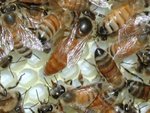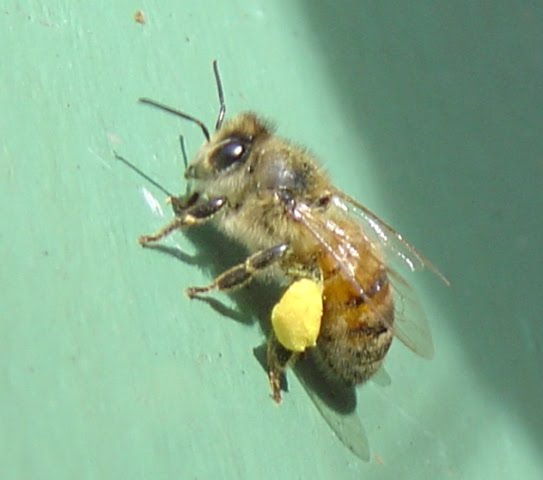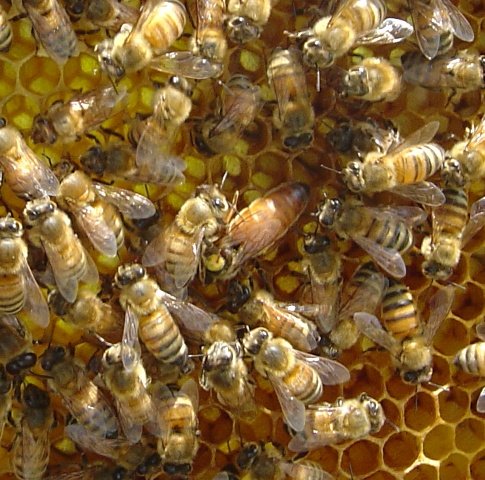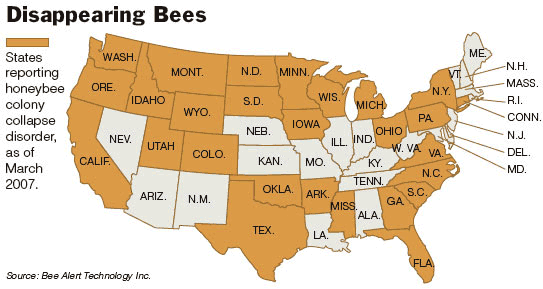Temperatures rose into the low 70’s this weekend, allowing for a quick inspection of the hives.
The crocus flowers are blooming, allowing the bees to collect much needed spring pollen. The pollen they collect will be used to boost brood production as they “build up” in size in preparation for the spring honey flow.
The crocus flowers are blooming, allowing the bees to collect much needed spring pollen. The pollen they collect will be used to boost brood production as they “build up” in size in preparation for the spring honey flow.
Right: The first Crocus to emerge on our property, and a week early too!
The warm temperatures over the past few days have been a wonderful reminder of days to come.
Several times I found myself sitting out near the hives just watching them fly in and out, heavily burdened with yellow packages of pollen on their back legs. Some bees were busy dragging out the dead from winter loses, while others just seemed happy to get out and into the sun shine.
I have been keeping a written record of the progress of the hives over the past years, and I am happy to report that the crocus bloom is running about a week ahead of schedule…. An early spring.
I guess the Ground Hog was wrong!
I guess the Ground Hog was wrong!
Left: A worker bee returning to the hive with some of the first spring pollen.
As I mentioned the rise in temperature allowed a quick inspection of some of the hives. Sure enough, young brood, and capped larva were observed on two if not three frames of bees. The queens probably started laying eggs sometime in February.
Some cells and already emerged, perhaps these were the bees I watched taking their first orientation flights in the sun.
Pollen patties were once again added to the hives. I have been surprised how quickly they have been consumed. Each colony has been through a patty a week since the beginning of March. In a few more weeks we will begin providing sugar syrup to the hives to imitate the collection of nectar. This will stimulate the queens to lay even more eggs, and cause the hives to build up faster.
Above: With the cover and inner cover removed you can see the new small hive beetle trap installed. The trap is baited with an attactant oil. The bees will chase the beetles, and the beetles should enter the trap to hide, where they will meet there demise. You can also see a new pollen patty just added to the colony along with the remains of the white bee candy. The yellow "frame" to the far right is a division board feeder which will be used to feed the bees sugar syrup next month.
Now is our buildup time. The more bees in the colonies come May. The more honey will be on the hives in August.
Some dead hive beetles were found on the sticky boards below the screened bottom boards. This indicates that some hive beetles are continuing to survive, with the bees, through the winter. I purchased two different types of beetle traps to use in addition to the bottom board traps I have been using. These new traps fit between the frames in the upper hive body. They are baited with an attractant oil. I have not used these before. I hope they work. The next inspection will show if this trap works.
I plan on drinking this mead while we are extracting honey this Septermber!
Left: Progress of the mead I started in February. You can see how much it has cleared over the past month. To the right is a photo taken at the height of fermentation.
The bee candy was once again added where needed, even though there is still abundant honey still in the combs. The bees have now been “trained” to feed off of this candy, although with so much honey left in the comb these hives will have to be watched carefully for swarming in the months to come.
I had quite the feeling of accomplishment this weekend. It is nice that all of the hives survived this winter. Perhaps, after 31 years, I have finally figured out how to prepare them for winter.
Or perhaps, I was just lucky.





















